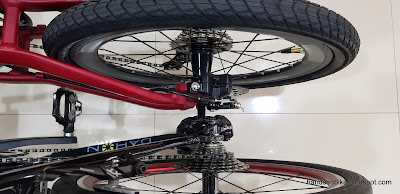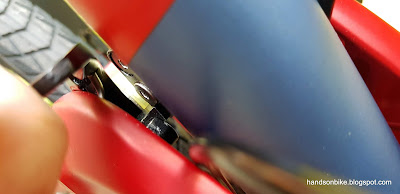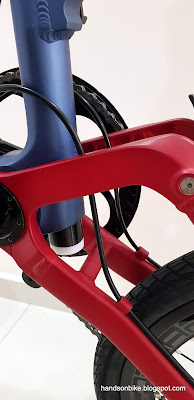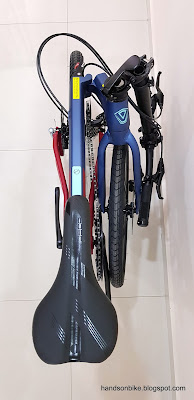For comparison, I used the Dahon MuEX as that is the only 20" folding bike that I have currently. For those who know, the Dahon MuEX is a high end Dahon folding bike, with many top level and lightweight components. However, for this comparison, I will not be comparing the bike weight or components specifications, as components can be changed easily. Furthermore, it is not fair to compare the stock components of the Java Neo 2 to the upgraded components of the Dahon MuEX.
What I will compare is generally the bike geometry and size, plus other features such as ease of folding. The Dahon MuEX geometry will be representative of most other 20" Dahon folding bikes. First, let's look at the wheelbase and overall length of these two bikes.
Same as for other bike geometry comparisons, I used the centre of the bottom bracket as the datum for aligning the bikes.
Chain stay length of the Dahon MuEX is slightly longer than the Java Neo 2, by about 10mm.
Distance from front hub to bottom bracket is also longer on the Dahon MuEX, by about 25mm.
Bottom bracket on the Java Neo 2 is higher than the Dahon MuEX, which is quite unusual. This might be due to the folding rear triangle design which requires this.
What this means is that the wheelbase of the Java Neo 2 is shorter than the Dahon MuEX, while the bottom bracket is higher. This means less stability on the Java Neo 2 as the wheelbase is shorter, while the centre of gravity is higher due to the higher bottom bracket.
Java Neo 2
Chainstay length: 390mm
Wheelbase: 985mm
BB height: 310mm
Dahon MuEX
Chainstay length: 400mm
Wheelbase: 1020mm
BB height: 284mm
Height of top tube (or main frame) is about the same at the head tube area. However, the Dahon MuEX frame curves downwards near the seat tube. This means that step over height is about the same.
How about the folded size? This is a very important factor as a folding bike needs to fold easily and compactly, in order to justify the higher weight and cost compared to a non-folding bike of the same specifications.
When folded, the Java Neo 2 is about the same length, but is quite a bit taller, due to the long seat post and the high seat tube. This is a big issue for me as I cannot fit the Java Neo 2 upright into the back of the car, unlike the Dahon MuEX.
For folded width, both bikes are about the same, even though the Dahon MuEX handlepost folds inwards while the Java Neo 2 handlepost folds outwards.
Up till now, we can see that the Java Neo 2's folded size is taller than the Dahon MuEX, even though it has an innovative new folding design. In my opinion, if a new folding design does not result in a more compact fold or easier fold, what is the point? It may be cool or interesting to have a new folding method, but it has to be at least equal in size to the market standard, which is the Dahon fold.
If a new folding method results in a smaller folded size, it may be acceptable to have a more complicated fold. Or, if the folded size is larger, but is easier to fold, it may also be acceptable. Some other folding bikes also have a larger folded size plus a more complicated fold, but they have other features. For example, the Birdy fold is larger and more complicated than a Dahon, but it has full suspension. A Tyrell FX also folds larger and is more complicated than a Dahon, but it rides very well due to the rigid frame.
However, in this case, the Java Neo 2 has a larger folded size, plus a more difficult fold (refer to Part 2), with no other feature that makes it better than a Dahon.
Let's check out the weight of some stock components. From what I see, the handlepost can be easily upgraded to a more lightweight type (non-adjustable), while the handlebar components (shifters, brake levers, grips) are more or less standard with similar weight no matter what you upgrade to.
The stock crankset is a square taper type, which is quite heavy. Upgrading to a Hollowtech II type of crankset and bottom bracket will save quite a bit of weight. The exact weight is not known as I will not be disassembling those parts.
However, other components that are easily removed will be weighed, such as those shown below.
Weight of super long seat post (650mm) plus stock saddle is 761 grams. In comparison, a Litepro seatpost (320g) plus a mid range saddle (230g) will weigh just 550 grams.
Weight of high profile front wheel (wheel + tire + tube + rotor + QR axle) is 1639 grams. In comparison, a Wheelsport Smart front wheel (584g) + Kojak (230g) + tube (100g) + rotor (125g) + QR axle (50g) will be just 1089 grams. Much room to save weight here.
Weight of high profile rear wheel (wheel + tire + tube + rotor + QR axle + cassette) is 2083 grams. In comparison, a Wheelsport Smart rear wheel (793g) + Kojak (230g) + tube (100g) + rotor (125g) + QR axle (65g) + cassette (300g) will be just 1613 grams.
From this, we can see that the stock high profile wheelset is quite heavy. Changing to a mid range Wheelsport Smart 1.0 wheelset plus better Kojak tires would save you 1 kg, while keeping the other parts the same. If you spend more for high end parts (lightweight wheelset and tires, titanium QR axles, etc), you can save another 300 grams or so from just the wheelset.
With these weight estimates of the various bike components, plus the weight of the overall bike, I was able to make a rough estimate of the frame weight (main frame + rear triangle only). This is just an estimate as I do not have the exact weight of many other components, but it should be around this range.
Full bike weight is 12.3 kg without pedals in stock condition. After deducting the weight of all the components, the estimated frame weight is 3.6 kg. This does not include the front fork. For comparison, the other bike frame weights are shown below. Some of these weights include the rear derailleur hanger or seat post clamp, or the headset weight, so the comparison is not exactly accurate, but the general trend is there.
Frame only weight estimates (excluding fork)
Java Neo 2: 3600 grams
Dahon MuEX/MuSP: 2400 grams
Crius AEV20: 2440 grams
Wheelsport Fantasy: 1760 grams
Java Freccia: 1060 grams
Merida Scultura 5000: 1000 grams
Canyon Endurace: 807 grams
Fabike C3: 1296 grams
Note that the Java Freccia, Merida Scultura 5000, Canyon Endurace, and Fabike C3 are carbon frames, while the others are aluminium frames.
From this frame weight comparison, we can see that the weight of the Java Neo 2 is not competitive at all, being much heavier than the aluminium Dahon frame. The carbon frame version of the Java Neo will weigh less, but it will also cost a lot more.
From this frame weight comparison, we can see that the weight of the Java Neo 2 is not competitive at all, being much heavier than the aluminium Dahon frame. The carbon frame version of the Java Neo will weigh less, but it will also cost a lot more.
Disadvantages of Java Neo 2 compared to Dahon
1) Taller folded size.
2) Long seat post is necessary for folding, cannot change to shorter and lighter seatpost.
3) Frame is heavier than Dahon.
4) Folding and unfolding steps is awkward.
5) Some lateral flex (between seat tube and rear triangle) at rubber stopper area.
6) Not possible to change to 451 wheels as it will affect the folding.
Advantages of Java Neo 2 compared to Dahon
1) Drivetrain is tucked inside when folded.
2) Can lay the frame down on the side easily, ideal for putting into car boot lying down.
3) Frame folding lever is nicely integrated into the frame.
The conclusion for me is that the Java Neo 2 is not good enough to replace the Dahon MuEX. On its own, the Java Neo 2 is a decent folding bike. With its unique folding design and sharp appearance, it looks quite good. However, in my case, it is not better than a Dahon in terms of weight, folded size or ease of folding.


























































